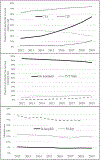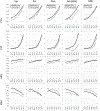Updated Trends, Disparities, and Clinical Impact of Neuroimaging Utilization in Ischemic Stroke in the Medicare Population: 2012 to 2019
- PMID: 35483436
- PMCID: PMC9308737
- DOI: 10.1016/j.jacr.2022.03.008
Updated Trends, Disparities, and Clinical Impact of Neuroimaging Utilization in Ischemic Stroke in the Medicare Population: 2012 to 2019
Abstract
Objective: The purpose of this study was to update trends, investigate sociodemographic disparities, and evaluate the impact on mortality of stroke neuroimaging across the United States from 2012 to 2019.
Methods: Retrospective cohort study using CMS Medicare 5% Research Identifiable Files, representing consecutive ischemic stroke emergency department or hospitalized patients aged ≥65 years. A total of 85,547 stroke episodes with demographic and clinical information were analyzed using Cochran-Mantel-Haenszel tests and logistic regression. Outcome measures were neuroimaging (CT angiography [CTA], CT perfusion [CTP], MRI, MR angiography [MRA]) utilization, acute treatment (endovascular thrombectomy [EVT] and intravenous thrombolysis [IVT]), and mortality while in the hospital and at 30 days and 1 year post discharge.
Results: Significantly increasing utilization trends for CTA (250%), CTP (428%) and MRI (18%), and a decreasing trend for MRA (-33%) were observed from 2012 to 2019 (P < .0001). Controlling for covariates in the logistic regression models, CTA and CTP were significantly associated with higher EVT and IVT utilization. Although CTA, MRI, and MRA were associated with lower mortality, CTP was associated with higher mortality post discharge. Less neuroimaging was performed in rural patients; older patients (≥80 years) had lower utilization of CTA, MRI, and MRA; female patients had lower rates of CTA; and Black patients had lower utilization of CTA and CTP.
Conclusions: CTA and CTP utilization increased in the Medicare ischemic stroke population from 2012 to 2019 and both were associated with greater EVT and IVT use. However, disparities exist in neuroimaging utilization across all demographic groups, and further understanding of the root causes of these disparities will be crucial to achieving equity in stroke care.
Keywords: Angiography; ischemic stroke; neuroimaging; perfusion; trend analysis.
Copyright © 2022 American College of Radiology. Published by Elsevier Inc. All rights reserved.
Conflict of interest statement
Figures



Comment in
-
Increased Versus Appropriate Neuroimaging Utilization in Stroke: A Complex Matter.J Am Coll Radiol. 2022 Dec;19(12):1300. doi: 10.1016/j.jacr.2022.05.025. Epub 2022 Jul 31. J Am Coll Radiol. 2022. PMID: 35922019 No abstract available.
-
Upward Utilization Rates of Neuroimaging in Ischemic Stroke in the Last Two Decades: Improving Patients' Outcomes or Increasing Health Care Cost?J Am Coll Radiol. 2022 Sep;19(9):1015-1017. doi: 10.1016/j.jacr.2022.05.029. Epub 2022 Jul 31. J Am Coll Radiol. 2022. PMID: 35922020 No abstract available.
References
-
- Powers WJ, Derdeyn CP, Biller J, et al. 2015 American Heart Association/American Stroke Association Focused Update of the 2013 Guidelines for the Early Management of Patients With Acute Ischemic Stroke Regarding Endovascular Treatment: A Guideline for Healthcare Professionals From the American Heart Association/American Stroke Association. Stroke. 2015;46(10):3020–3035. doi:10.1161/STR.0000000000000074 - DOI - PubMed
Publication types
MeSH terms
Grants and funding
LinkOut - more resources
Full Text Sources
Medical

